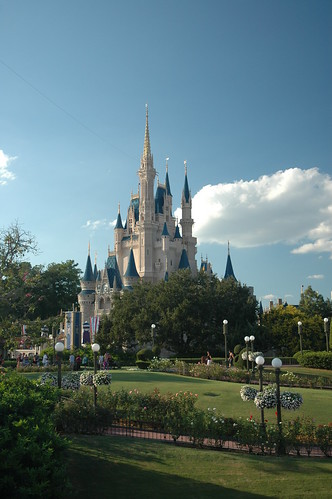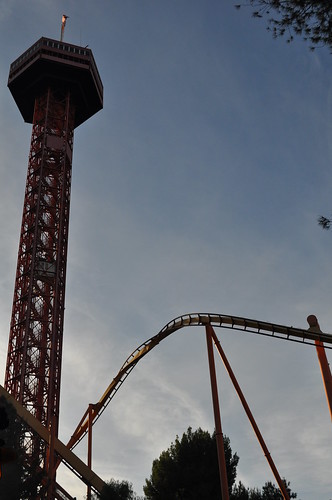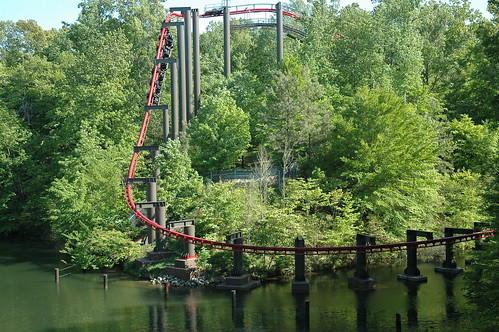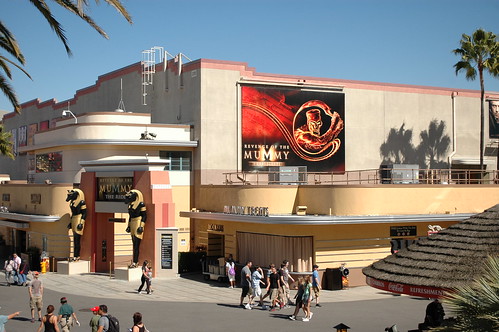One of the first parks in the US to begin "layering" their attractions was Disneyland. The Haunted Mansion begins with an elevator trip taking guests one story below the main level of the park. In a park where space is at a serious premium, placing part of an attraction below the mean park elevation allowed designers to hide the ride building while still allowing icons like Sleeping Beauty's Castle and The Matterhorn to be visible from around the park. Pirates of the Caribbean and Indiana Jones and the Temple of the Forbidden Eye also utilize attraction space that is below surface grade. However those two attractions do so to create much larger spaces for visual effect more so than design necessity.

Walt Disney recognized that the need be able to use space beneath a theme park was critical to operation and sustainability of the park. When he designed Magic Kingdom in Florida, the entire park was built on top of an elaborate maze of tunnels, storage space, maintenance facilities, and other rooms. The entire park is essentially built on top of a basement that supports park operations. Instead of having to dedicate valuable street level space to storage and operational support, Magic Kingdom can utilize almost every square inch of surface space for attractions, retail, and guest space. From costume storage to server rooms, the sub-grade space beneath the Magic Kingdom is essential to the park's success. The Keys to the Kingdom Tour offers guests an opportunity to see exactly how integral the subsurface support space is to the operation of the park.

Not many theme parks have gone to the extreme of Magic Kingdom's use of subsurface space to support theme park operations, but many others have used topography to their advantage. Six Flags Magic Mountain is built around a local topographic high which offers challenges to theme park design. Magic Mountain has taken on that challenge head on by designing rides that are custom-built into the terrain. From La Revolution to Tatsu to Ninja to this year's Full Throttle, the park has used its natural topography to an advantage by building one-of-a-kind attractions that could not be built anywhere else.

While the main part of Six Flags Fiesta Texas is a mostly flat piece of property at the bottom of a rock quarry, two of its signature roller coasters are built into the walls of the quarry. Superman: Krypton Coaster and The Rattler use the shear cliff faces to great advantage. The park also utilizes the quarry walls as a backdrop of their nighttime show like a giant projection screen.
Alton Towers in the United Kingdom has gouged the earth to accommodate world class rides that would otherwise be impossible because of local height restrictions. Oblivion and Nemesis would not have been built if park designers did not remake the earth. Not only would the rides have not been possible, but by constructing them into ravines and tunnels, it makes the coasters far more exciting. Busch Gardens made a similar design choice when they built Montu at their Tampa park. Montu has almost as much track above the mean surface elevation as there is below ground. It not only adds excitement to the coaster as the track flips and spins through troughs and ravines, but is allows it to achieve greater speeds and G forces.
In the early days of wooden roller coasters, it was common to see parks use the natural hills and valleys to dictate the design and layout of the coaster. Even more modern wooden roller coasters utilize the lay of the land in their design. The Beast, with its massive spiraling helix, would be very different on a flat piece of ground. The designers of The Voyage deliberately designed the coaster's series of airtime hills and signature tunnel with topography in mind.

While it's definitely easier and cheaper to build stock rides on flat pieces of land, parks that embrace their topography and add topography to their parks are certainly more interesting. A park like Busch Gardens Williamsburg can be a chore to walk around with its undulating hills, valleys, and bridges, but the park uses that topography to create breaks between different themed areas.


However, not all parks have taken their topography to their advantage. Universal Studios Hollywood has probably some of the most challenging terrain of any theme park in the world, literally built into the Hollywood Hills. When the park wanted to expand, instead of building directly adjacent to existing park land, which would have requires a serious investment to remake the terrain, the park found the closest flat piece of the studio lot that was not being used, and built a quarter-mile complex of escalators to the new Lower Lot. The result is a theme park that is a serious chore to navigate, and an even bigger challenge for the park to balance crowds and staff.

Remaking the Earth and using natural topography is something park designers have been doing for decades. Many parks prefer to just build on flat land, and spread attractions across their property, while others use topography to their advantage, or layer their attractions to take advantage of their limited space. As land becomes scarcer, and parks look to expand and enhance their attractions, using topography, and remaking the Earth will be critical to the success of theme parks.
Tweet
This article has been archived and is no longer accepting comments.